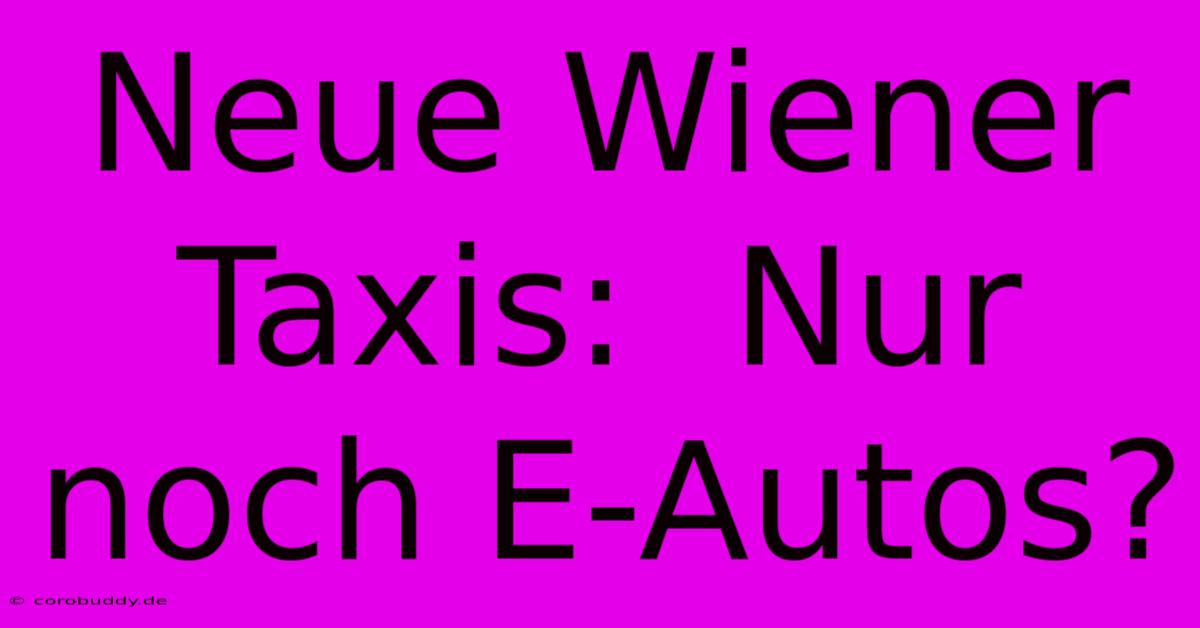Neue Wiener Taxis: Nur Noch E-Autos?

Discover more detailed and exciting information on our website. Click the link below to start your adventure: Visit Best Website Neue Wiener Taxis: Nur Noch E-Autos?. Don't miss out!
Table of Contents
Neue Wiener Taxis: Nur noch E-Autos? Ein Blick hinter die Kulissen
Hey Leute! Let's talk about something that's been buzzing around Vienna lately – the whole electric taxi thing. Specifically, Neue Wiener Taxis and their push towards being all-electric. It's a pretty big deal, right? I mean, imagine Vienna, all buzzing with silent, zero-emission cabs. Sounds dreamy, doesn't it?
But is it really all sunshine and roses? Let's dive in.
Meine eigene Erfahrung mit Wiener E-Taxis
So, a few weeks ago, I needed a taxi – like, really needed one. It was raining cats and dogs, I was late for a wichtiger meeting, and my phone battery was about to die. Naturally, I hailed a taxi. And guess what? It was electric! Super sleek, quiet, and smelled…well, it didn't smell like anything, which was kinda weird at first, but definitely better than exhaust fumes.
The ride itself was smooth. No rattling, no loud engine noises – just the gentle hum of the electric motor. I was impressed. The driver, a super-nice guy, told me about the challenges of driving an electric taxi in Vienna. He talked about charging infrastructure – or rather, the lack thereof – and the range anxiety that comes with it. He said sometimes, he has to make extra stops to charge up, which can throw off his schedule.
Die Realität: Mehr als nur E-Autos
The whole "Nur noch E-Autos" thing? It's not quite that simple. While Neue Wiener Taxis are definitely pushing hard towards an all-electric fleet, it's a massive undertaking. Think about it: Replacing hundreds, maybe thousands of vehicles isn't a weekend project. It takes time, money, and a whole lot of planning.
Furthermore, the city's charging infrastructure needs to keep pace. You need enough charging stations – really enough, not just a few scattered around – to support a large fleet of electric taxis. Otherwise, you'll have drivers constantly searching for power, impacting their efficiency and potentially leading to higher fares.
And what about the drivers themselves? Transitioning to electric vehicles requires training and adapting to new technologies. There might be anxieties around range, charging times, and potential maintenance issues. We need to support the drivers through this transition; they are the backbone of this system, after all.
Herausforderungen und Chancen
The move to electric taxis presents both huge challenges and equally massive opportunities. From an environmental perspective, it's fantastic – less pollution in our beautiful city! But there are logistical hurdles – infrastructure, driver training, and the sheer cost of transitioning to a whole new fleet of vehicles.
I predict that, although fully electric taxis in Vienna are still on the horizon, we will see a gradual change. The combination of government incentives, improvements in charging infrastructure, and increasing acceptance of electric vehicles should lead to a significantly higher percentage of electric taxis on Vienna’s streets in the next few years.
What about you? Have you taken an electric taxi in Vienna yet? Let me know your experiences in the comments below! Let's discuss this together. This is important, so please share your thoughts and opinions.

Thank you for visiting our website wich cover about Neue Wiener Taxis: Nur Noch E-Autos?. We hope the information provided has been useful to you. Feel free to contact us if you have any questions or need further assistance. See you next time and dont miss to bookmark.
Featured Posts
-
20 000 Euro Erbe Zu Gewinnen
Nov 22, 2024
-
Northvolt Beantragt Insolvenz In Usa
Nov 22, 2024
-
Oberhofer Skispringer Im Weltcup
Nov 22, 2024
-
Mega Dr Martens Black Friday Deal
Nov 22, 2024
-
Augsburg Kaempft Gegen Bayern
Nov 22, 2024
